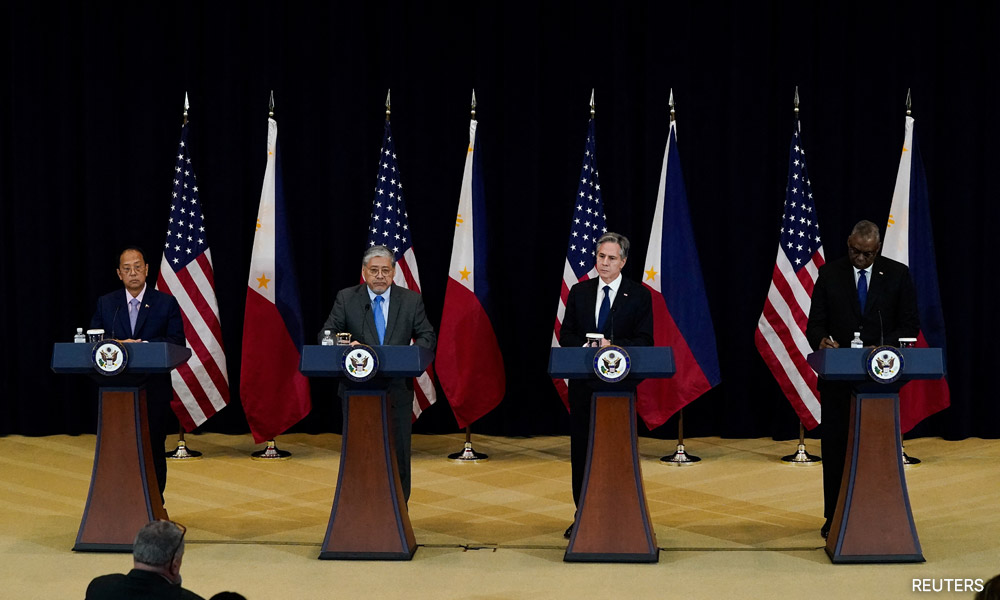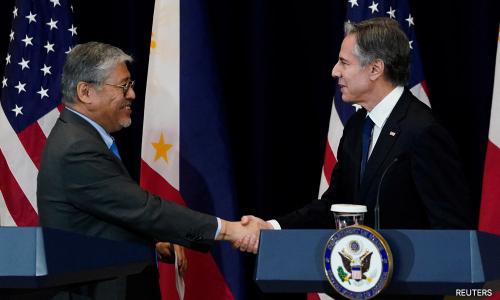US, Philippines agree to complete road map for security assistance
The top defence and diplomatic officials from the US and Philippines agreed yesterday to complete a road map in the coming months to cover the delivery of US defence assistance to the Philippines over the next five to 10 years.
US Defense Secretary Lloyd Austin said the long-time allies, which share concerns about an increasingly assertive China, discussed delivery of "priority defence platforms".
This includes radars, drones, military transport aircraft and coastal and air defence systems at a so-called 2+2 meeting in Washington that also involved US Secretary of State Antony Blinken and his Philippine counterparts.
A joint statement reads, "adoption of a Security Sector Assistance Roadmap in the coming months will guide shared defence modernisation investments and inform the delivery of priority platforms over the next five to 10 years."
Philippines Foreign Minister Enrique Manalo (above, left) told the same news conference the two sides "redoubled" their commitment to modernising the Philippines-US alliance.
This was in recognition that "our partnership will need to play a stronger role in preserving an international law-based international order."
Experts say the US sees the Philippines as a potential location for rockets, missiles and artillery systems to counter a Chinese amphibious invasion of Taiwan - which China claims as its own.
Austin said that it was "too early" to discuss what assets the US would like to station at Philippine military bases under a recently expanded Enhanced Defense Cooperation Agreement (EDCA).
Manalo said the EDCA sites were mainly aimed at improving military interoperability, addressing potential humanitarian disasters "and perhaps, responding to other types of security challenges," but did not elaborate.
The Pentagon has not specifically said what the additional sites will be used for, except that work would include airport expansion and training involving naval assets.

Manalo said on Monday that Washington and Manila will need to discuss what the US may do with its access to the EDCA sites.
EDCA allows US access to Philippine bases for joint training, pre-positioning of equipment and building of facilities such as runways, fuel storage and military housing, but not a permanent presence.
The joint statement said the US expects to boost its allocated spending for EDCA sites to over US$100 million (RM441 million) by the end of 2023, against a previously announced US$80 million (RM353 million).
The two sides also agreed to fast-track new bilateral defence guidelines.
Southeast Asia expert Greg Poling at Washington's Center for Strategic and International Studies said such guidelines were aimed at providing strategic direction and laying out each side's responsibilities.
"The US and Japan negotiated defence guidelines in 1978 for the Cold War, 1998 focused on North Korea, and 2015 focused on China, whereas the US and Philippines have never done so," he said.
The Washington meeting came after more than 17,000 Philippine and US soldiers began their largest-ever joint military drills on Tuesday, highlighting their shared concern about China, which has rival territorial claims to the Philippines in the disputed South China Sea.
US-Philippines relations have warmed considerably under Philippines President Ferdinand Marcos Jr, and the 2+2 meeting underlined that as the first of its kind in seven years.
But Manila treads a delicate path with China, the region's economic powerhouse.
Marcos assured China on Monday that military bases accessible to the US would not be used in offensive action, stressing that the arrangement with Washington was designed to boost his country's defences.
- Reuters
RM12.50 / month
- Unlimited access to award-winning journalism
- Comment and share your opinions on all our articles
- Gift interesting stories to your friends
- Tax deductable

